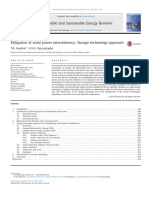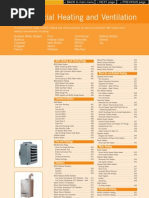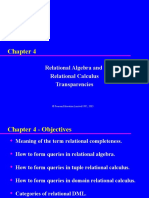Maximum Likelihood Estimation: ' (t, θ) = - X, θ), - X, θ) denotes the density of t X
Maximum Likelihood Estimation: ' (t, θ) = - X, θ), - X, θ) denotes the density of t X
Uploaded by
Leonard Gonzalo Saavedra AstopilcoCopyright:
Available Formats
Maximum Likelihood Estimation: ' (t, θ) = - X, θ), - X, θ) denotes the density of t X
Maximum Likelihood Estimation: ' (t, θ) = - X, θ), - X, θ) denotes the density of t X
Uploaded by
Leonard Gonzalo Saavedra AstopilcoOriginal Title
Copyright
Available Formats
Share this document
Did you find this document useful?
Is this content inappropriate?
Copyright:
Available Formats
Maximum Likelihood Estimation: ' (t, θ) = - X, θ), - X, θ) denotes the density of t X
Maximum Likelihood Estimation: ' (t, θ) = - X, θ), - X, θ) denotes the density of t X
Uploaded by
Leonard Gonzalo Saavedra AstopilcoCopyright:
Available Formats
492
Discrete and Limited Dependent Variables
h(t)
5.0
...
.....
........
..
........
........
.
.
4.5 .... Weibull, = 1, = 0.5
.
.
.
.
.
.......
...
........
...
........
........
.
.
.
.
.
.
.
.
Weibull, = 1, = 1.5.............
4.0 ...
...
...
.......
..........
...
..
.
......
.
.
.......
.
.
.
.
.
.
.
.
.
.
.
.
......
.
.
3.5 ...
...... ...................
...
...
................
...
.....
.
......
1
.....
....Lognormal,
= 0, =
3.0 ....
......
.......
.....
...
3
...
.
......
.
.
.
.
.
.
.
.
.
.
........
...
...
...
......
.
.
.
.
.
.
.
.
.
.
.........
2.5 ...
.....
..
...........
.....
...
.....
......
.....
......
......
....
...
............
.....
.
.
.
.
.
..............................
.
.
.
.
.
.
.
.
.
.
.
.
.
.
.
.
.
.
.
.
.
.
.
.
.
.
.
.
.
.
.
...
.
.
.
.
.
.
.
2.0 ...
.
.
.
.
.
.
.
.
.
.
.
.
.
.
.
.
.
.
.
.
.
....
.
.
.
.
.
.
.
.
.
.
...
.
.
.... ..........
.
.
.
.
.
.
............
...
..
........ .. ....
................ .............................. Weibull, = 1, = 1.25
1.5 ....
.
... ......... ............
... ................
Exponential, = 1
.
.
.
.
.
1.0 ..........................................................................................................................................................................................................................................................................................................................................
............. .. ...............
.
...........
.............. Lognormal, = 0, = 1
........ ........
0.5 .............. ... ........................ ........................................................................................................................
............................................................. ...........................................................................
..... ..
.............................................
... ..
.. ..
.
....
t
0.0
0
1
2
3
4
5
6
7
8
9
10
Figure 11.4 Various hazard functions
Maximum Likelihood Estimation
It is reasonably straightforward to estimate many duration models by maximum likelihood. In the simplest case, the data consist of n independent
observations ti on observed durations, each with an associated regressor vector Xi . The loglikelihood function for t, the vector of observations with typical
element ti , is just
n
X
`(t, ) =
log f (ti | Xi , ),
(11.84)
i=1
where f (ti | Xi , ) denotes the density of ti conditional on the data vector
Xi for the parameter vector . In many cases, it may be easier to write the
loglikelihood function as
`(t, ) =
n
X
i=1
log h(ti | Xi , ) +
n
X
log S(ti | Xi , ),
(11.85)
i=1
where h(ti | Xi , ) is the hazard function and S(ti | Xi , ) is the survivor function. The equivalence of (11.84) and (11.85) is ensured by (11.81), in which
the hazard function was defined.
As with other models we have looked at in this chapter, it is convenient to let
the loglikelihood depend on explanatory variables through an index function.
As an example, suppose that duration follows a Weibull distribution, with
You might also like
- Article 500-516 of NEC (Atex Material, Crouse-Hinds 2017)Document128 pagesArticle 500-516 of NEC (Atex Material, Crouse-Hinds 2017)txagusNo ratings yet
- Hmi DVP PDFDocument160 pagesHmi DVP PDFAdayroi AtuNo ratings yet
- ShockwavesDocument52 pagesShockwavesMustafaNo ratings yet
- PV Elite User's Guide 7Document2 pagesPV Elite User's Guide 7ghostamirNo ratings yet
- Enganches PH HollanDocument80 pagesEnganches PH Hollanafaba5No ratings yet
- Parts 9108-4020 7-06-07 ANSI English PDFDocument312 pagesParts 9108-4020 7-06-07 ANSI English PDFduongpnNo ratings yet
- The Potentialofusingnanofluids InPEMfuelcellcoolingsystemsDocument17 pagesThe Potentialofusingnanofluids InPEMfuelcellcoolingsystemsMario MandžukićNo ratings yet
- Unit 5 - TestDocument8 pagesUnit 5 - Testevioktavianti260619No ratings yet
- Section F Temp Voltage ControlDocument132 pagesSection F Temp Voltage ControlalltheloveintheworldNo ratings yet
- Renewable and Sustainable Energy Reviews: Serhat KucukaliDocument7 pagesRenewable and Sustainable Energy Reviews: Serhat KucukaliAlejandro Duvan Lopez RojasNo ratings yet
- Additional Information About The scrlttr2 Class and The Scrletter PackageDocument1 pageAdditional Information About The scrlttr2 Class and The Scrletter Packagefrenchman55No ratings yet
- Crouse Hinds Codedigest2020Document130 pagesCrouse Hinds Codedigest2020jenna lee100% (1)
- Ppi TR 03 2024Document93 pagesPpi TR 03 2024ari rahadyanNo ratings yet
- Mdcat LoversDocument784 pagesMdcat Loverssobaanakhtar123No ratings yet
- Mazda RX 7 1993 1995 Parts CatalogueDocument1 pageMazda RX 7 1993 1995 Parts Cataloguestaci100% (63)
- Eder Er 2015Document13 pagesEder Er 2015maulikgadaraNo ratings yet
- Issues Concerning Roughness On Wind Turbine BladesDocument12 pagesIssues Concerning Roughness On Wind Turbine BladesSNADA100% (1)
- Chp#1 Three Stats of Matter P2Document5 pagesChp#1 Three Stats of Matter P2AyaanNo ratings yet
- Antonio U 2013Document20 pagesAntonio U 2013jahidulNo ratings yet
- Well Service Catalog 2018 MinDocument50 pagesWell Service Catalog 2018 MinAgustinus KNo ratings yet
- Bai Tap Trich Dan TLTKDocument2 pagesBai Tap Trich Dan TLTKPham Khanh ThoNo ratings yet
- Rx7 Collision RepairDocument13 pagesRx7 Collision RepairJay CiscoNo ratings yet
- A Comparative Study of Fatigue Behaviour of Flax-Epoxy and Glass-Epoxy CompositesDocument9 pagesA Comparative Study of Fatigue Behaviour of Flax-Epoxy and Glass-Epoxy Compositesrahul reddyNo ratings yet
- Chapter 20: Using IBIS ModelsDocument1 pageChapter 20: Using IBIS ModelsThiện KhiêmNo ratings yet
- Ayodele - Mitigation of Wind Power Intermittency Storage Techonology ApproachDocument10 pagesAyodele - Mitigation of Wind Power Intermittency Storage Techonology ApproachBrian LozaNo ratings yet
- Drying of PolymersDocument29 pagesDrying of PolymersHimanshu PanchalNo ratings yet
- Bioquimica 3Document16 pagesBioquimica 3Via PetitNo ratings yet
- GasTurbOver PDocument36 pagesGasTurbOver Pأيمن ادريباتNo ratings yet
- Endura 1Document652 pagesEndura 1Sudhir KayasthaNo ratings yet
- Orange SectionDocument78 pagesOrange SectionseanfsmythNo ratings yet
- MPMS AC Option User Manual A0Document56 pagesMPMS AC Option User Manual A0478684354No ratings yet
- 41 Drying of PolymersDocument29 pages41 Drying of PolymersThai AnhNo ratings yet
- t2 Chem Revision Ex 12Document16 pagest2 Chem Revision Ex 12Nicholas OwNo ratings yet
- Atomic Data and Nuclear Data TablesDocument19 pagesAtomic Data and Nuclear Data Tableshoaian1970ktNo ratings yet
- Aerogel Insulation For Building Applications: A State-Of-The-Art ReviewDocument9 pagesAerogel Insulation For Building Applications: A State-Of-The-Art ReviewDanitza Del Rosario Perca MachacaNo ratings yet
- Cap 437 Dec16 PDFDocument305 pagesCap 437 Dec16 PDFErwin De RamaNo ratings yet
- CHEN 623 Lecture Notes (2021 08 31)Document545 pagesCHEN 623 Lecture Notes (2021 08 31)YENUGULA DAVID VENKATNo ratings yet
- Structural Design PDFDocument683 pagesStructural Design PDFKanenus B Finfinnee100% (1)
- CAC 2017 DataSheets PDFDocument143 pagesCAC 2017 DataSheets PDFMilena Rocío LamonegaNo ratings yet
- Progress in Aerospace Sciences: Bhupendra Khandelwal, Adam Karakurt, Paulas R. Sekaran, Vishal Sethi, Riti SinghDocument15 pagesProgress in Aerospace Sciences: Bhupendra Khandelwal, Adam Karakurt, Paulas R. Sekaran, Vishal Sethi, Riti SinghMarcelo Roberti Rocha FantaguzziNo ratings yet
- TESSLibs17 General Descriptions PDFDocument79 pagesTESSLibs17 General Descriptions PDFhoangpalestineNo ratings yet
- 17 Maschinenverzeichnis enDocument4 pages17 Maschinenverzeichnis enJD6 AgarbNo ratings yet
- Renewable and Sustainable Energy Reviews: Amir Shara Fian, Majid BahramiDocument12 pagesRenewable and Sustainable Energy Reviews: Amir Shara Fian, Majid Bahramirao_saintNo ratings yet
- Fifty Years of Hypersonics - Where Weve Been Where Were GoingDocument26 pagesFifty Years of Hypersonics - Where Weve Been Where Were GoingMADDI MADHAV.No ratings yet
- CHANCE® Technical Design Manual - Edition 3Document410 pagesCHANCE® Technical Design Manual - Edition 3Red Snapper100% (4)
- Airbus NotesDocument117 pagesAirbus Notesdc932No ratings yet
- 11.1 New Energetics TestDocument7 pages11.1 New Energetics TestLaura WooNo ratings yet
- Wear WellDocument62 pagesWear WellMohammed ToemaNo ratings yet
- CHANCE+Technical+Design+Manual-Ed +3+compressedDocument414 pagesCHANCE+Technical+Design+Manual-Ed +3+compressedManuel Flores100% (2)
- Buttons and LightsDocument171 pagesButtons and LightsRJTNo ratings yet
- Assignment No.3 Atomic Structure)Document2 pagesAssignment No.3 Atomic Structure)misbah shahidNo ratings yet
- Ul Fm Uf Md Co2 Design Manual Design Co2 Total Flooding Nfpa12 Rv04Document69 pagesUl Fm Uf Md Co2 Design Manual Design Co2 Total Flooding Nfpa12 Rv04alirezanami679No ratings yet
- Manual SwitcherDocument80 pagesManual SwitcherDAN ROSALES FILMSNo ratings yet
- NATO MOD Part 1Document38 pagesNATO MOD Part 1Arun Kastwar0% (2)
- choe2015Document9 pageschoe2015xiaochi1989No ratings yet
- Drafting Purchase Price Adjustment Clauses in M&A: Guarantees, retrospective and future oriented Purchase Price Adjustment ToolsFrom EverandDrafting Purchase Price Adjustment Clauses in M&A: Guarantees, retrospective and future oriented Purchase Price Adjustment ToolsNo ratings yet
- Why Heaven Kissed Earth: The Christology of the Puritan Reformed Orthodox theologian, Thomas Goodwin (1600–1680)From EverandWhy Heaven Kissed Earth: The Christology of the Puritan Reformed Orthodox theologian, Thomas Goodwin (1600–1680)No ratings yet
- Temperley-Lieb Recoupling Theory and Invariants of 3-ManifoldsFrom EverandTemperley-Lieb Recoupling Theory and Invariants of 3-ManifoldsNo ratings yet
- Benefits of semantic data models. A study in the European goods transport industryFrom EverandBenefits of semantic data models. A study in the European goods transport industryNo ratings yet
- Massachusetts Institute of Technology Department of Economics Working Paper SeriesDocument24 pagesMassachusetts Institute of Technology Department of Economics Working Paper SeriesLeonard Gonzalo Saavedra AstopilcoNo ratings yet
- Y ⊗ I − X β k WBΓDocument2 pagesY ⊗ I − X β k WBΓLeonard Gonzalo Saavedra AstopilcoNo ratings yet
- 13.8 Final Remarks: t p i=1 i t−i t p i i ε p j - i−j -Document1 page13.8 Final Remarks: t p i=1 i t−i t p i i ε p j - i−j -Leonard Gonzalo Saavedra AstopilcoNo ratings yet
- 600 Methods For Stationary Time-Series Data: I I J JDocument1 page600 Methods For Stationary Time-Series Data: I I J JLeonard Gonzalo Saavedra AstopilcoNo ratings yet
- T T T T: Granger CausalityDocument1 pageT T T T: Granger CausalityLeonard Gonzalo Saavedra AstopilcoNo ratings yet
- Σ β X Σ ⊗ I X Σ ⊗ I ,Document1 pageΣ β X Σ ⊗ I X Σ ⊗ I ,Leonard Gonzalo Saavedra AstopilcoNo ratings yet
- PG 464Document1 pagePG 464Leonard Gonzalo Saavedra AstopilcoNo ratings yet
- 500 Discrete and Limited Dependent Variables: y C A HDocument1 page500 Discrete and Limited Dependent Variables: y C A HLeonard Gonzalo Saavedra AstopilcoNo ratings yet
- R Elements, Which Are The R - Vector G: I) PlimDocument1 pageR Elements, Which Are The R - Vector G: I) PlimLeonard Gonzalo Saavedra AstopilcoNo ratings yet
- Exact Confidence Regions For Regression ParametersDocument1 pageExact Confidence Regions For Regression ParametersLeonard Gonzalo Saavedra AstopilcoNo ratings yet
- The Power of Bootstrap TestsDocument2 pagesThe Power of Bootstrap TestsLeonard Gonzalo Saavedra AstopilcoNo ratings yet
- TH TH 1: This Procedure Would Not Work If, For Example, All of The Original Instruments Were Binary VariablesDocument1 pageTH TH 1: This Procedure Would Not Work If, For Example, All of The Original Instruments Were Binary VariablesLeonard Gonzalo Saavedra AstopilcoNo ratings yet
- 3.3 Are OLS Parameter Estimators Consistent?Document2 pages3.3 Are OLS Parameter Estimators Consistent?Leonard Gonzalo Saavedra AstopilcoNo ratings yet
- 6.9 Final Remarks: K K I K IDocument1 page6.9 Final Remarks: K K I K ILeonard Gonzalo Saavedra AstopilcoNo ratings yet
- PG 010Document1 pagePG 010Leonard Gonzalo Saavedra AstopilcoNo ratings yet
- Solution To Exercise 15.20: Econometric Theory and MethodsDocument4 pagesSolution To Exercise 15.20: Econometric Theory and MethodsLeonard Gonzalo Saavedra AstopilcoNo ratings yet
- Solution To Exercise 15.4: R R 1 R R, ZDocument2 pagesSolution To Exercise 15.4: R R 1 R R, ZLeonard Gonzalo Saavedra AstopilcoNo ratings yet
- Solution To Exercise 14.24: ?14.24 Let A (A ADocument2 pagesSolution To Exercise 14.24: ?14.24 Let A (A ALeonard Gonzalo Saavedra AstopilcoNo ratings yet
- Solution to Exercise 15.3: ?15.3 Suppose the dependent variable y is generated by the DGP y = Xβ u ∼ N (0, σDocument1 pageSolution to Exercise 15.3: ?15.3 Suppose the dependent variable y is generated by the DGP y = Xβ u ∼ N (0, σLeonard Gonzalo Saavedra AstopilcoNo ratings yet
- Solution To Exercise 15.21: Econometric Theory and MethodsDocument1 pageSolution To Exercise 15.21: Econometric Theory and MethodsLeonard Gonzalo Saavedra AstopilcoNo ratings yet
- Exercise 15.12Document2 pagesExercise 15.12Leonard Gonzalo Saavedra AstopilcoNo ratings yet
- Civil 3 DDocument21 pagesCivil 3 DSilviu Mariut100% (1)
- OOAD QuizDocument8 pagesOOAD Quizvijayan m gNo ratings yet
- Free PDF Maps IndiaDocument2 pagesFree PDF Maps IndiaHeatherNo ratings yet
- Package Nnet': R Topics DocumentedDocument11 pagesPackage Nnet': R Topics DocumentedDiegoPedroNo ratings yet
- Database Management Practical FileDocument17 pagesDatabase Management Practical FileKunal Mathur100% (1)
- Baio Bayesian Health Economics PDFDocument67 pagesBaio Bayesian Health Economics PDFferNo ratings yet
- Java OOPs Concepts - JavatpointDocument6 pagesJava OOPs Concepts - JavatpointJagadishBabu ParriNo ratings yet
- Validation and Verification of Simulation ModelsDocument20 pagesValidation and Verification of Simulation ModelsMinh Ngọc HuỳnhNo ratings yet
- XDocument20 pagesXAlberto BarrosNo ratings yet
- Design Final 1Document16 pagesDesign Final 1Alex33% (3)
- DBMS-Rajib Mall - Unit I NotesDocument16 pagesDBMS-Rajib Mall - Unit I NotesvenniraselviNo ratings yet
- The Deep Learning Revolution: Introductory Overview LectureDocument35 pagesThe Deep Learning Revolution: Introductory Overview LectureAnji M ReddyNo ratings yet
- Relational FinTop FinAssets FinFaDepreciationTrans - FinFaTrackingDocument1 pageRelational FinTop FinAssets FinFaDepreciationTrans - FinFaTrackingKhalil De la CruzNo ratings yet
- CS619 Final Project Final Viva Preparation Filefor PresentationDocument49 pagesCS619 Final Project Final Viva Preparation Filefor PresentationV SSNo ratings yet
- CheatsDocument28 pagesCheatsNeil YoungNo ratings yet
- Classes and ObjectsDocument13 pagesClasses and ObjectsSUJITHMVNo ratings yet
- Modelling With UML in Software EngineeringDocument64 pagesModelling With UML in Software EngineeringJimmeyNo ratings yet
- Lecture 1Document22 pagesLecture 1MSaqibKhanNo ratings yet
- Datamodelling TrainingDocument7 pagesDatamodelling Trainingjakegeorge123No ratings yet
- EIE4105 Multimodal Human Computer Interaction Technology: Fundamental of Statistical LearningDocument31 pagesEIE4105 Multimodal Human Computer Interaction Technology: Fundamental of Statistical LearningtchxiNo ratings yet
- Quantile RegressionDocument6 pagesQuantile RegressionHassaanAhmadNo ratings yet
- Unit 1Document48 pagesUnit 1Rahul Harsh Rajé0% (1)
- System ModelingDocument37 pagesSystem ModelingFaröuq d'CröwNo ratings yet
- Relational Algebra and Relational CalculusDocument57 pagesRelational Algebra and Relational CalculusSyedkareem_hkgNo ratings yet
- 4.5 Detailed Syllabus of BCA 5 Semester: 1. BCS-051: Introduction To Software Engineering 3 CreditsDocument1 page4.5 Detailed Syllabus of BCA 5 Semester: 1. BCS-051: Introduction To Software Engineering 3 CreditsSebastianNo ratings yet
- SrsDocument63 pagesSrsrahulrnair4u_5534754No ratings yet
- Wzzvm M¨Vm: Welq: Md&Uiq¨Vi Μq Cöm‡½ -Document4 pagesWzzvm M¨Vm: Welq: Md&Uiq¨Vi Μq Cöm‡½ -Anonymous jvaG8m7No ratings yet
- Mathematical Statistics - WikiDocument5 pagesMathematical Statistics - WikiAlex ChenNo ratings yet
- Dbms Lab Lab Assignments: Week 5Document2 pagesDbms Lab Lab Assignments: Week 5Sudip PandaNo ratings yet













































































































